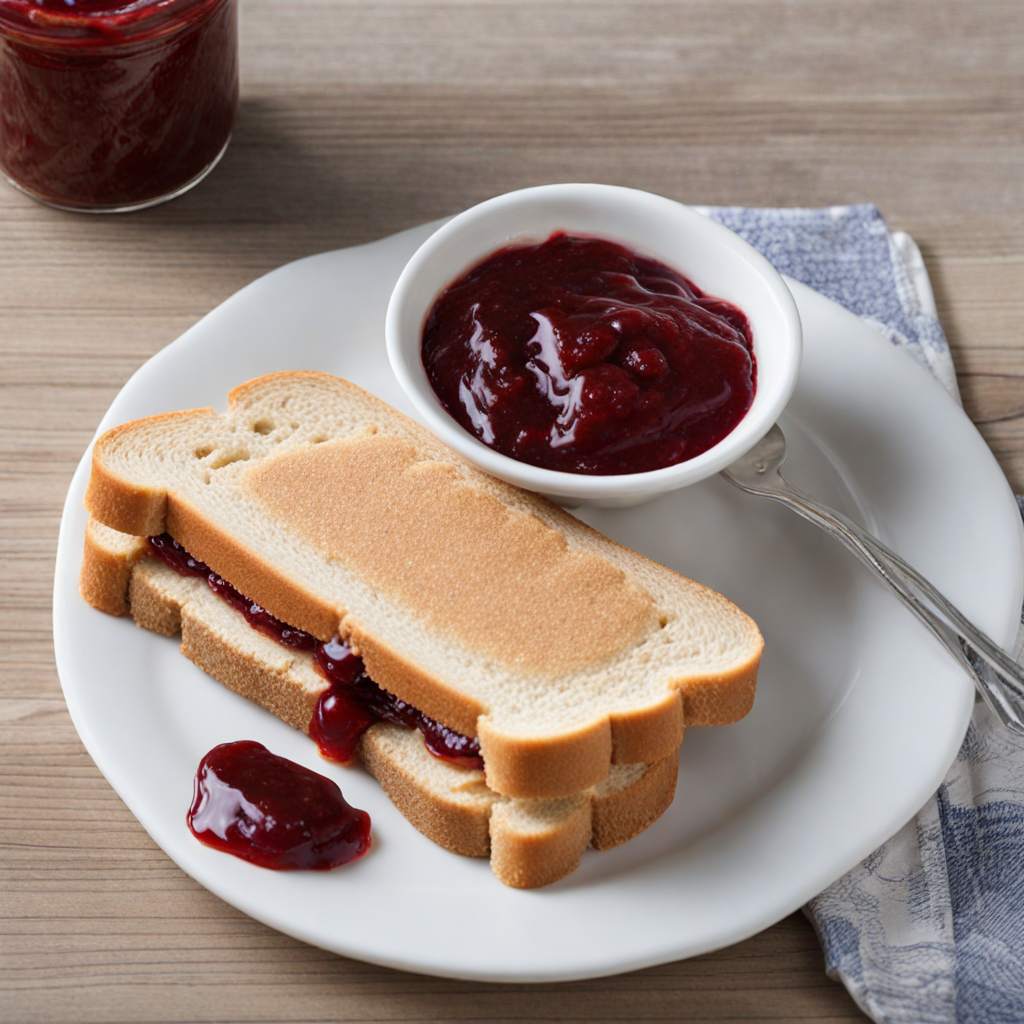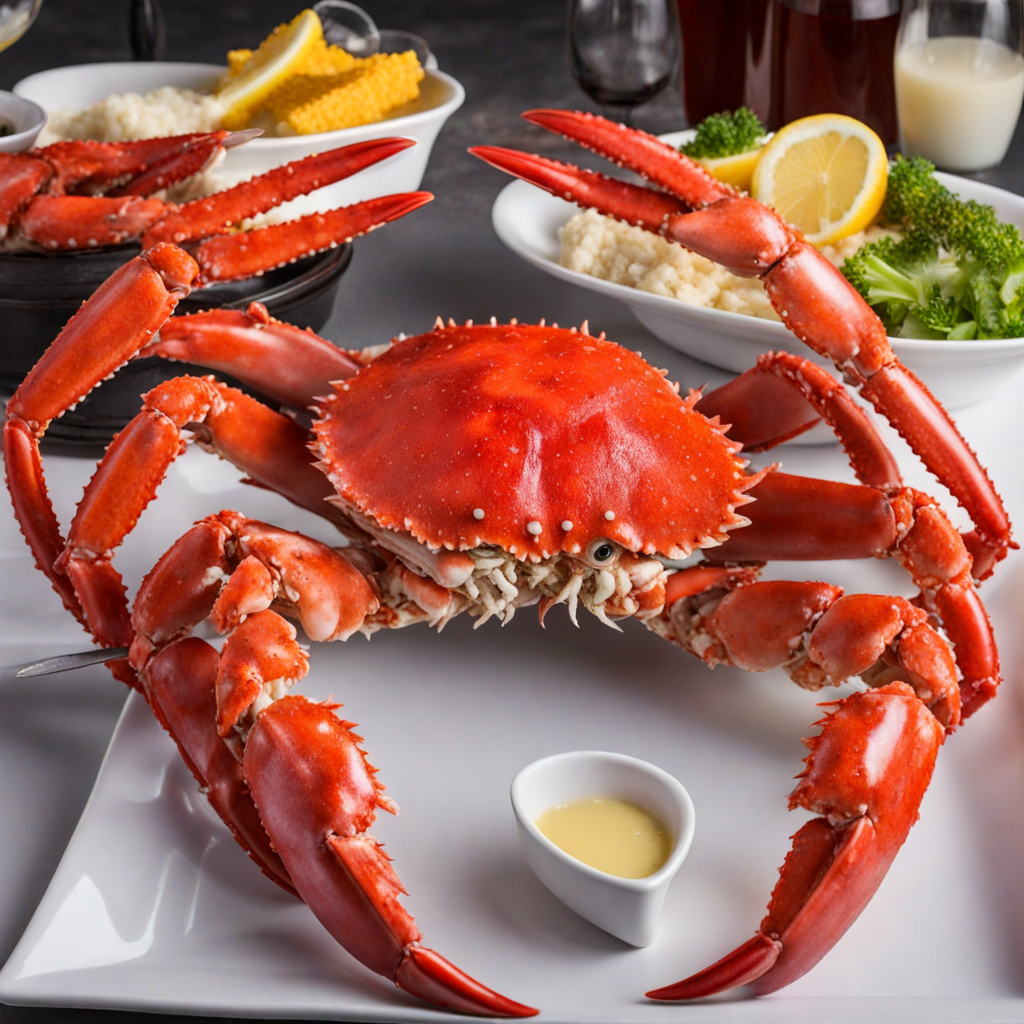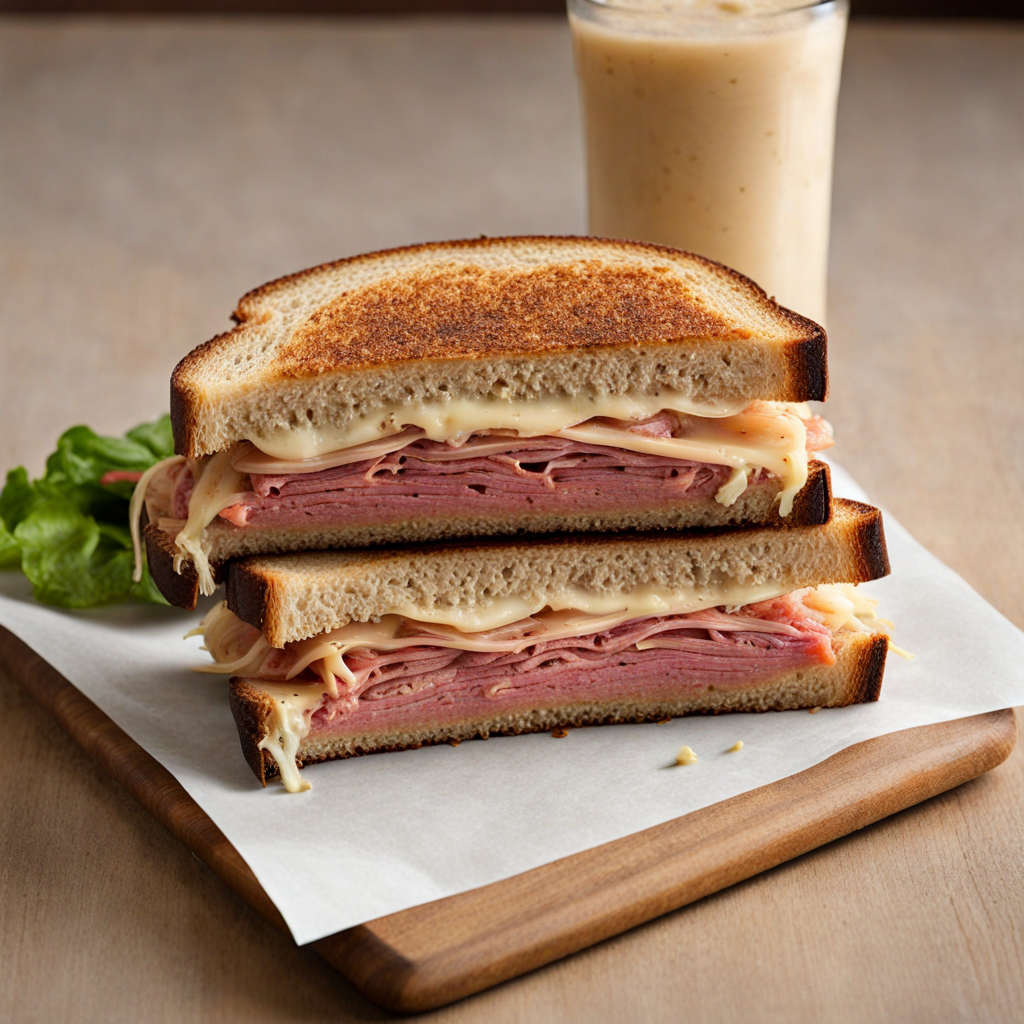Peanut Butter and Jelly Sandwich
The Peanut Butter and Jelly Sandwich is a quintessential American classic, beloved for its simplicity and delightful combination of flavors. At its core, this sandwich features two slices of bread—typically white or whole wheat—that serve as the canvas for a generous spread of creamy or crunchy peanut butter on one side and sweet fruit preserves or jelly on the other. The contrast between the rich, nutty taste of the peanut butter and the fruity sweetness of the jelly creates a harmonious balance that tantalizes the taste buds and provides a comforting experience with every bite. The choice of jelly or preserves adds a personal touch, with options ranging from classic grape or strawberry to more adventurous flavors like raspberry or apricot. Each variety brings its unique sweetness and acidity, enhancing the overall flavor profile of the sandwich. The texture of the peanut butter, whether smooth or crunchy, complements the spread, offering a delightful mouthfeel that pairs well with the soft bread. It's a dish that not only appeals to children but also evokes nostalgia in adults, making it a staple in lunchboxes across the country. Peanut Butter and Jelly Sandwiches are incredibly versatile and can be enjoyed in various settings, from a quick midday snack to a beloved picnic staple. They can be customized with additional ingredients like banana slices, honey, or even a sprinkle of cinnamon for those looking to enhance their experience further. Whether eaten with a glass of cold milk or as part of a hearty lunch, this sandwich is a perfect representation of American comfort food, inviting everyone to savor its delicious simplicity and find joy in its timeless appeal.
How It Became This Dish
The History of the Peanut Butter and Jelly Sandwich The peanut butter and jelly sandwich (PB&J) is an iconic staple of American cuisine, beloved for its simplicity, affordability, and nostalgic value. This quintessential sandwich has become synonymous with childhood lunches, picnics, and the American experience itself. To truly understand the significance of PB&J, we must delve into its origins, evolution, and the cultural forces that shaped its place in American society. #### Origins of Peanut Butter The history of peanut butter can be traced back to ancient civilizations. Peanuts, native to South America, were cultivated by indigenous peoples as early as 3,500 years ago. The Spaniards brought peanuts back to Europe in the 16th century, and they eventually made their way to North America with African slaves who used them in traditional African dishes. However, peanut butter as we know it today began to emerge in the late 19th century. In 1884, Marcellus Gilmore Edson, a Canadian chemist, patented a method for making peanut paste, which was a ground peanut product that could be spread. Shortly thereafter, Dr. George Washington Carver, an African American agricultural scientist and inventor, popularized peanuts in the United States, promoting their cultivation and use in various products, including peanut butter. Carver's work in the early 20th century encouraged farmers to rotate crops and cultivate peanuts, significantly increasing its production. In 1895, a Boston physician, W. G. Freese, created a process to make peanut butter suitable for consumption, and by 1901, the first commercial peanut butter was produced by the L. T. Smith Company in St. Louis. However, it wasn’t until the early 1920s that peanut butter gained widespread popularity, thanks in part to the introduction of J.M. Smucker’s peanut butter jars and the innovative marketing strategies of companies like Skippy and Peter Pan. #### The Emergence of Jelly Alongside peanut butter, jelly has its own rich history. Fruit preserves and jellies date back to ancient times. The Romans made fruit preserves by boiling fruit with honey, while medieval Europeans created various jams and jellies using sugar that became increasingly accessible and affordable in the 16th century. In the United States, commercial jelly production began in the late 19th century. Companies like Smucker’s and Welch’s capitalized on the growing popularity of fruit spreads, producing grape jelly and other varieties that would eventually become staples in American households. #### The Birth of the PB&J Sandwich The peanut butter and jelly sandwich is believed to have originated in the United States in the early 20th century. While the exact date is difficult to pinpoint, the combination of peanut butter and jelly was mentioned in print as early as 1901, and soldiers during World War II were known to have taken peanut butter and jelly sandwiches in their rations. The sandwich gained popularity among American families during the Great Depression when its low cost made it an affordable meal option. The combination of protein-rich peanut butter and sweet, fruity jelly made for a filling and nutritious meal, appealing to both children and adults. By the 1950s and 1960s, the PB&J sandwich became a staple in American households. The post-war economic boom saw an influx of suburban families, and the convenience of the sandwich fit perfectly into the fast-paced lifestyles of the era. As schools began to institute lunch programs, PB&J sandwiches became a popular choice for packed lunches, solidifying their place in American culture. #### Cultural Significance The peanut butter and jelly sandwich transcends its humble ingredients. It represents comfort and nostalgia for many Americans, evoking memories of childhood, family gatherings, and carefree days spent in the summer sun. The sandwich is more than just food; it is a cultural icon that reflects the American values of simplicity, ingenuity, and accessibility. In the 1970s and 1980s, the PB&J sandwich began to take on additional layers of meaning. As the health food movement gained momentum, peanut butter became associated with wholesome, natural eating. The growing popularity of organic and natural food products led to an increase in artisanal peanut butters and gourmet jellies, reflecting changing consumer preferences. The sandwich adapted to these trends, with variations that included whole-grain bread, organic spreads, and exotic fruit jellies. #### Variations and Innovations Over the years, the PB&J sandwich has seen numerous variations and innovations. Gourmet versions featuring artisanal breads, homemade jellies, and flavored peanut butters have emerged in upscale cafes and restaurants. Some creative takes include adding ingredients like bananas, honey, or even bacon, appealing to adventurous eaters and foodies alike. In recent years, the rise of dietary restrictions and health consciousness has prompted further innovation. Gluten-free bread options have made the PB&J accessible to those with gluten sensitivities, while nut-free alternatives, such as sunflower seed butter, cater to individuals with nut allergies. These adaptations ensure that the beloved sandwich remains relevant in an ever-evolving food landscape. #### PB&J in Modern Culture Today, the peanut butter and jelly sandwich has a firm foothold in American culture. It is celebrated in literature, film, and art, often symbolizing the simplicity of childhood and the comfort of home. In 2014, the United States Congress even designated April 2nd as National Peanut Butter and Jelly Day, recognizing the sandwich's significance in American life. Moreover, the PB&J has become a vehicle for philanthropy. Organizations like the "PB&J Project" work to provide meals to those in need, using the sandwich as a symbol of nourishment and support for families facing food insecurity. #### Conclusion The peanut butter and jelly sandwich is more than just a meal; it is a cultural touchstone that reflects the American spirit. Its origins, rooted in agricultural innovation and economic necessity, have transformed it into an enduring symbol of comfort and nostalgia. As it continues to evolve with new adaptations and innovations, the PB&J will likely remain a beloved staple of American cuisine for generations to come. Whether enjoyed by children at lunchtime or gourmet foodies seeking a modern twist, the peanut butter and jelly sandwich embodies the essence of American food culture—simple, satisfying, and immensely cherished.
You may like
Discover local flavors from United States







